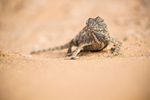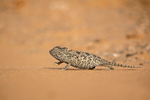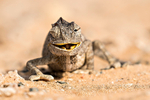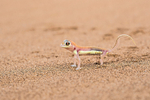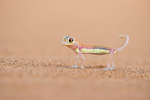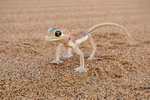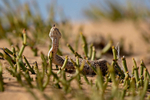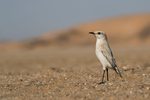The Namib Desert
The Namib Desert is undoubtedly one of the most famous deserts in the world.
Having been photographing some of the largest beasts (Elephants, Giraffe and Lions), now we were heading out to try and find, and photograph, some of the smallest. It was time to seek out the so-called "Little Five". Amongst their number are, the Namaqua Chameleon, Peringuey’s Adder, the Shovel-snouted Lizard, Palmato Gecko and the Cartwheeling Spider.
In the hope of achieving this, we joined a local guide, Tommy Collard, who leads a desert safari "The Living Desert Tour". Tommy’s depth of knowledge about the desert and all it’s wildlife was quite breath-taking.
This he happily shared with great enthusiasm
His ability to locate members of the Little Five was astounding. He was reading signs and tracks in the sand which we could barely see even when he literally pointed those marks out!
He managed to spot a small snake with just the top of its head and eyes poking above the sand from what must have been twenty yards away!
There was a brief comfort stop – and yes, there are portable loos in the desert!
A Tractrac Chat had chosen this site as part of its range and was quite happy to hunt for food amongst the sand just feet from the group.
Tommy found us examples of all the target species except for the Cart Wheeling Spider but I am happy to forgive him that – as it gives me an excuse to return another year.
In many of the photo's you will see what looks to be grains of black sand on the surface and in the initial panorama, large streaks of black too.
This black is not different coloured sad but is actually iron oxide, also known as Hematite. It occurs across swathes of the desert in significant, potentially commercial, quantities. Hopefully the national government will maintain its current restrictions preventing all commercial activity and thus preserve the stunning beauty of this desert.
Having been photographing some of the largest beasts (Elephants, Giraffe and Lions), now we were heading out to try and find, and photograph, some of the smallest. It was time to seek out the so-called "Little Five". Amongst their number are, the Namaqua Chameleon, Peringuey’s Adder, the Shovel-snouted Lizard, Palmato Gecko and the Cartwheeling Spider.
In the hope of achieving this, we joined a local guide, Tommy Collard, who leads a desert safari "The Living Desert Tour". Tommy’s depth of knowledge about the desert and all it’s wildlife was quite breath-taking.
This he happily shared with great enthusiasm
His ability to locate members of the Little Five was astounding. He was reading signs and tracks in the sand which we could barely see even when he literally pointed those marks out!
He managed to spot a small snake with just the top of its head and eyes poking above the sand from what must have been twenty yards away!
There was a brief comfort stop – and yes, there are portable loos in the desert!
A Tractrac Chat had chosen this site as part of its range and was quite happy to hunt for food amongst the sand just feet from the group.
Tommy found us examples of all the target species except for the Cart Wheeling Spider but I am happy to forgive him that – as it gives me an excuse to return another year.
In many of the photo's you will see what looks to be grains of black sand on the surface and in the initial panorama, large streaks of black too.
This black is not different coloured sad but is actually iron oxide, also known as Hematite. It occurs across swathes of the desert in significant, potentially commercial, quantities. Hopefully the national government will maintain its current restrictions preventing all commercial activity and thus preserve the stunning beauty of this desert.

